LAW 6000 - Business and Corporate Law: Detailed Case Study Analysis
VerifiedAdded on 2023/06/10
|9
|1963
|206
Case Study
AI Summary
This assignment presents three case studies within the realm of Business and Corporate Law. The first case examines partnership liability, focusing on whether a partnership is bound by a contract entered into by one partner and the potential legal recourse against that partner for exceeding authority. The second case delves into consumer law, specifically addressing misleading advertising under the Australian Consumer Law (ACL) and the enforceability of contracts when one party has limited English proficiency. The final case explores the doctrine of promissory estoppel, assessing whether a promise made by one party is legally binding, even without formal contract modifications. Each case study identifies the relevant legal issues, applies pertinent legal principles and case law, and arrives at a reasoned conclusion, providing a comprehensive legal analysis. The document is available on Desklib, a platform offering study tools and solved assignments for students.
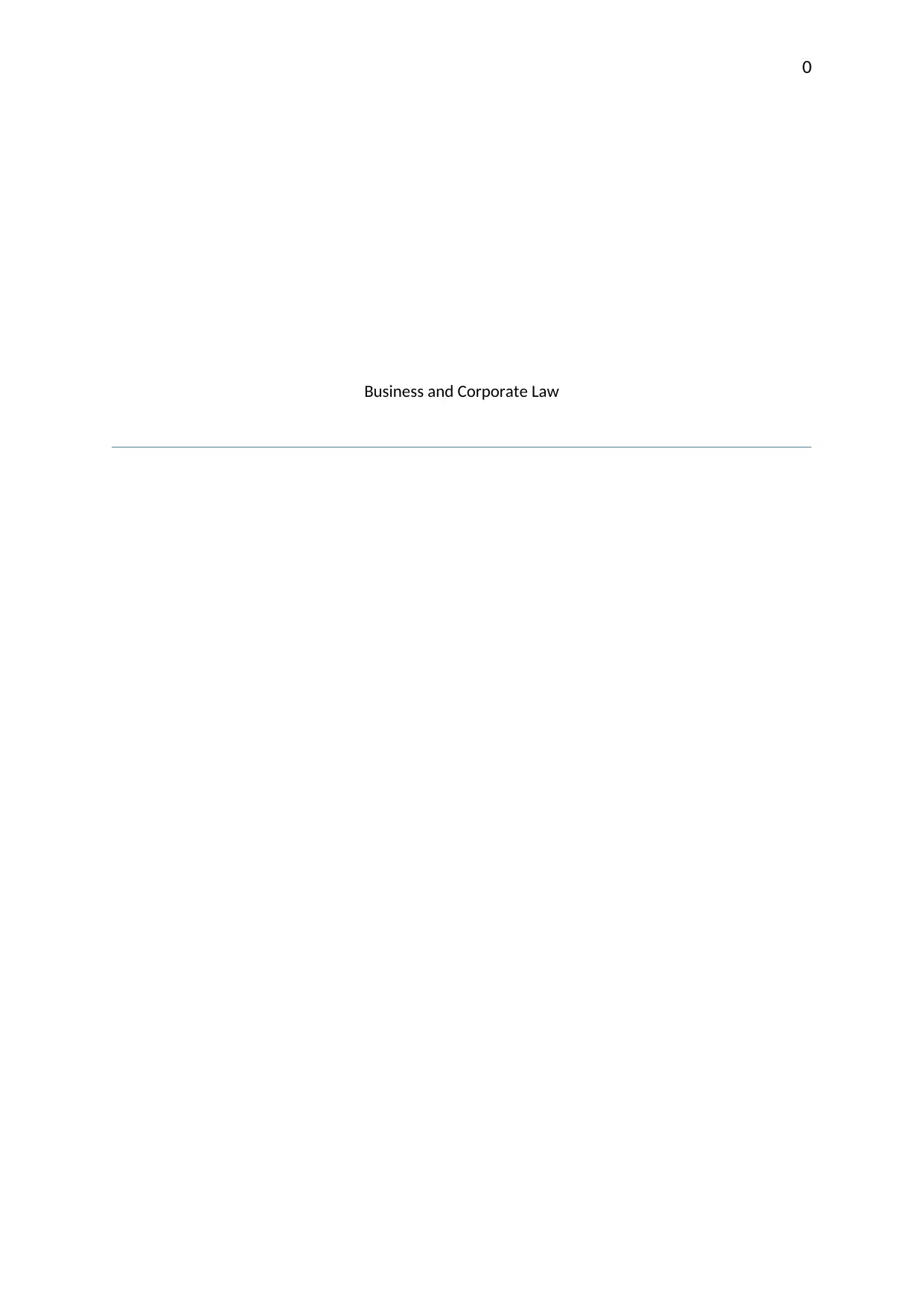
0
Business and Corporate Law
Business and Corporate Law
Paraphrase This Document
Need a fresh take? Get an instant paraphrase of this document with our AI Paraphraser
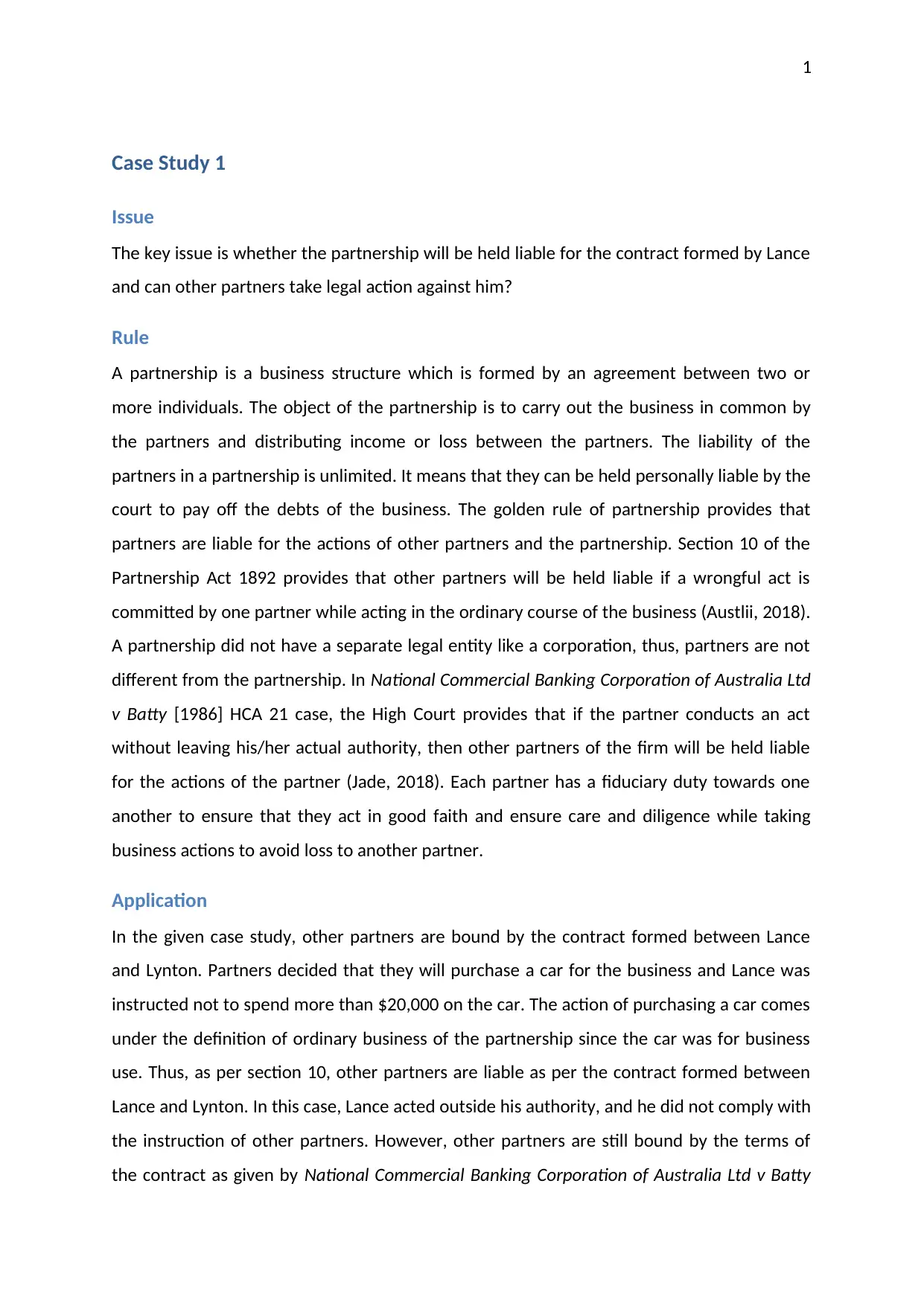
1
Case Study 1
Issue
The key issue is whether the partnership will be held liable for the contract formed by Lance
and can other partners take legal action against him?
Rule
A partnership is a business structure which is formed by an agreement between two or
more individuals. The object of the partnership is to carry out the business in common by
the partners and distributing income or loss between the partners. The liability of the
partners in a partnership is unlimited. It means that they can be held personally liable by the
court to pay off the debts of the business. The golden rule of partnership provides that
partners are liable for the actions of other partners and the partnership. Section 10 of the
Partnership Act 1892 provides that other partners will be held liable if a wrongful act is
committed by one partner while acting in the ordinary course of the business (Austlii, 2018).
A partnership did not have a separate legal entity like a corporation, thus, partners are not
different from the partnership. In National Commercial Banking Corporation of Australia Ltd
v Batty [1986] HCA 21 case, the High Court provides that if the partner conducts an act
without leaving his/her actual authority, then other partners of the firm will be held liable
for the actions of the partner (Jade, 2018). Each partner has a fiduciary duty towards one
another to ensure that they act in good faith and ensure care and diligence while taking
business actions to avoid loss to another partner.
Application
In the given case study, other partners are bound by the contract formed between Lance
and Lynton. Partners decided that they will purchase a car for the business and Lance was
instructed not to spend more than $20,000 on the car. The action of purchasing a car comes
under the definition of ordinary business of the partnership since the car was for business
use. Thus, as per section 10, other partners are liable as per the contract formed between
Lance and Lynton. In this case, Lance acted outside his authority, and he did not comply with
the instruction of other partners. However, other partners are still bound by the terms of
the contract as given by National Commercial Banking Corporation of Australia Ltd v Batty
Case Study 1
Issue
The key issue is whether the partnership will be held liable for the contract formed by Lance
and can other partners take legal action against him?
Rule
A partnership is a business structure which is formed by an agreement between two or
more individuals. The object of the partnership is to carry out the business in common by
the partners and distributing income or loss between the partners. The liability of the
partners in a partnership is unlimited. It means that they can be held personally liable by the
court to pay off the debts of the business. The golden rule of partnership provides that
partners are liable for the actions of other partners and the partnership. Section 10 of the
Partnership Act 1892 provides that other partners will be held liable if a wrongful act is
committed by one partner while acting in the ordinary course of the business (Austlii, 2018).
A partnership did not have a separate legal entity like a corporation, thus, partners are not
different from the partnership. In National Commercial Banking Corporation of Australia Ltd
v Batty [1986] HCA 21 case, the High Court provides that if the partner conducts an act
without leaving his/her actual authority, then other partners of the firm will be held liable
for the actions of the partner (Jade, 2018). Each partner has a fiduciary duty towards one
another to ensure that they act in good faith and ensure care and diligence while taking
business actions to avoid loss to another partner.
Application
In the given case study, other partners are bound by the contract formed between Lance
and Lynton. Partners decided that they will purchase a car for the business and Lance was
instructed not to spend more than $20,000 on the car. The action of purchasing a car comes
under the definition of ordinary business of the partnership since the car was for business
use. Thus, as per section 10, other partners are liable as per the contract formed between
Lance and Lynton. In this case, Lance acted outside his authority, and he did not comply with
the instruction of other partners. However, other partners are still bound by the terms of
the contract as given by National Commercial Banking Corporation of Australia Ltd v Batty
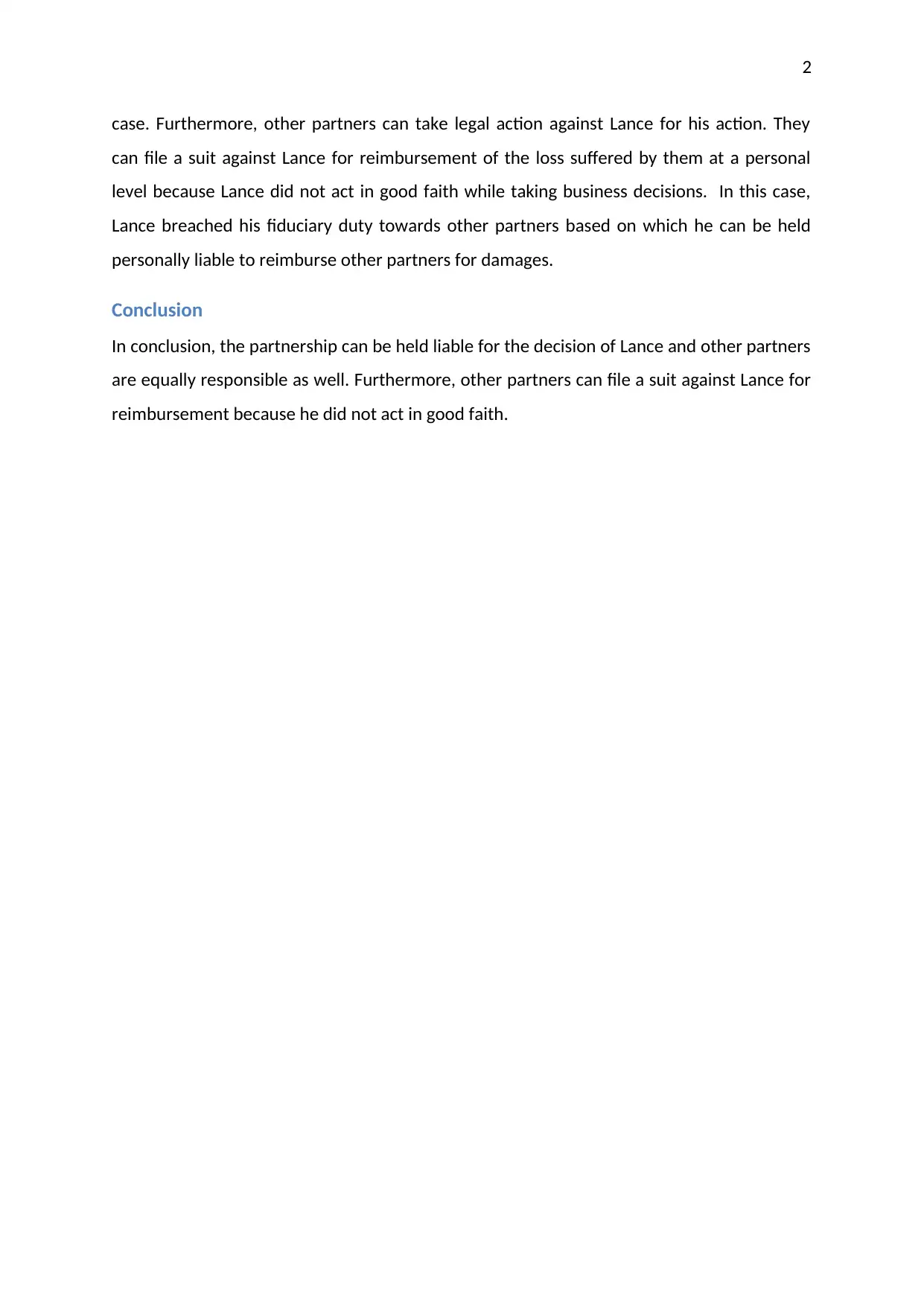
2
case. Furthermore, other partners can take legal action against Lance for his action. They
can file a suit against Lance for reimbursement of the loss suffered by them at a personal
level because Lance did not act in good faith while taking business decisions. In this case,
Lance breached his fiduciary duty towards other partners based on which he can be held
personally liable to reimburse other partners for damages.
Conclusion
In conclusion, the partnership can be held liable for the decision of Lance and other partners
are equally responsible as well. Furthermore, other partners can file a suit against Lance for
reimbursement because he did not act in good faith.
case. Furthermore, other partners can take legal action against Lance for his action. They
can file a suit against Lance for reimbursement of the loss suffered by them at a personal
level because Lance did not act in good faith while taking business decisions. In this case,
Lance breached his fiduciary duty towards other partners based on which he can be held
personally liable to reimburse other partners for damages.
Conclusion
In conclusion, the partnership can be held liable for the decision of Lance and other partners
are equally responsible as well. Furthermore, other partners can file a suit against Lance for
reimbursement because he did not act in good faith.
⊘ This is a preview!⊘
Do you want full access?
Subscribe today to unlock all pages.

Trusted by 1+ million students worldwide
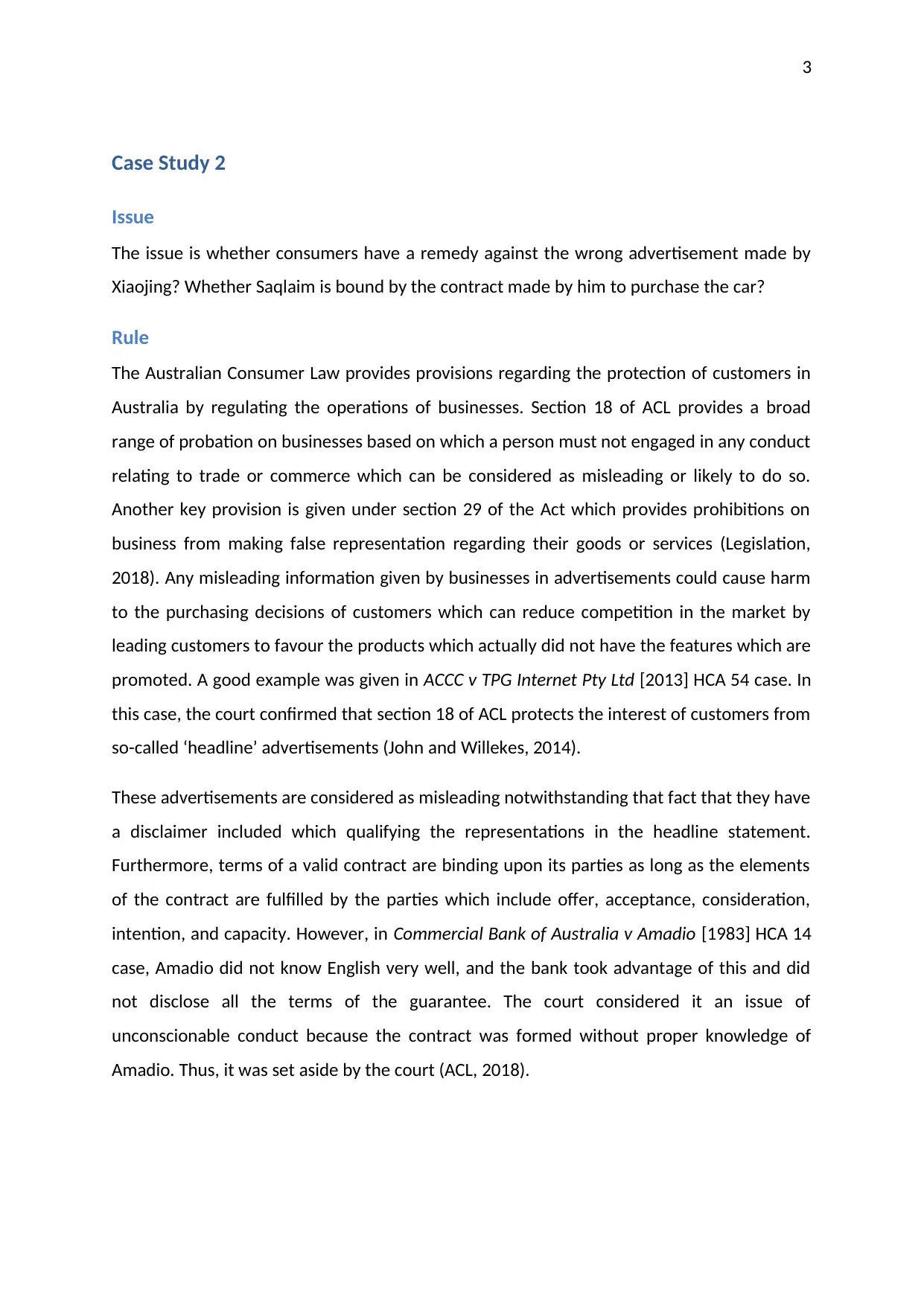
3
Case Study 2
Issue
The issue is whether consumers have a remedy against the wrong advertisement made by
Xiaojing? Whether Saqlaim is bound by the contract made by him to purchase the car?
Rule
The Australian Consumer Law provides provisions regarding the protection of customers in
Australia by regulating the operations of businesses. Section 18 of ACL provides a broad
range of probation on businesses based on which a person must not engaged in any conduct
relating to trade or commerce which can be considered as misleading or likely to do so.
Another key provision is given under section 29 of the Act which provides prohibitions on
business from making false representation regarding their goods or services (Legislation,
2018). Any misleading information given by businesses in advertisements could cause harm
to the purchasing decisions of customers which can reduce competition in the market by
leading customers to favour the products which actually did not have the features which are
promoted. A good example was given in ACCC v TPG Internet Pty Ltd [2013] HCA 54 case. In
this case, the court confirmed that section 18 of ACL protects the interest of customers from
so-called ‘headline’ advertisements (John and Willekes, 2014).
These advertisements are considered as misleading notwithstanding that fact that they have
a disclaimer included which qualifying the representations in the headline statement.
Furthermore, terms of a valid contract are binding upon its parties as long as the elements
of the contract are fulfilled by the parties which include offer, acceptance, consideration,
intention, and capacity. However, in Commercial Bank of Australia v Amadio [1983] HCA 14
case, Amadio did not know English very well, and the bank took advantage of this and did
not disclose all the terms of the guarantee. The court considered it an issue of
unconscionable conduct because the contract was formed without proper knowledge of
Amadio. Thus, it was set aside by the court (ACL, 2018).
Case Study 2
Issue
The issue is whether consumers have a remedy against the wrong advertisement made by
Xiaojing? Whether Saqlaim is bound by the contract made by him to purchase the car?
Rule
The Australian Consumer Law provides provisions regarding the protection of customers in
Australia by regulating the operations of businesses. Section 18 of ACL provides a broad
range of probation on businesses based on which a person must not engaged in any conduct
relating to trade or commerce which can be considered as misleading or likely to do so.
Another key provision is given under section 29 of the Act which provides prohibitions on
business from making false representation regarding their goods or services (Legislation,
2018). Any misleading information given by businesses in advertisements could cause harm
to the purchasing decisions of customers which can reduce competition in the market by
leading customers to favour the products which actually did not have the features which are
promoted. A good example was given in ACCC v TPG Internet Pty Ltd [2013] HCA 54 case. In
this case, the court confirmed that section 18 of ACL protects the interest of customers from
so-called ‘headline’ advertisements (John and Willekes, 2014).
These advertisements are considered as misleading notwithstanding that fact that they have
a disclaimer included which qualifying the representations in the headline statement.
Furthermore, terms of a valid contract are binding upon its parties as long as the elements
of the contract are fulfilled by the parties which include offer, acceptance, consideration,
intention, and capacity. However, in Commercial Bank of Australia v Amadio [1983] HCA 14
case, Amadio did not know English very well, and the bank took advantage of this and did
not disclose all the terms of the guarantee. The court considered it an issue of
unconscionable conduct because the contract was formed without proper knowledge of
Amadio. Thus, it was set aside by the court (ACL, 2018).
Paraphrase This Document
Need a fresh take? Get an instant paraphrase of this document with our AI Paraphraser
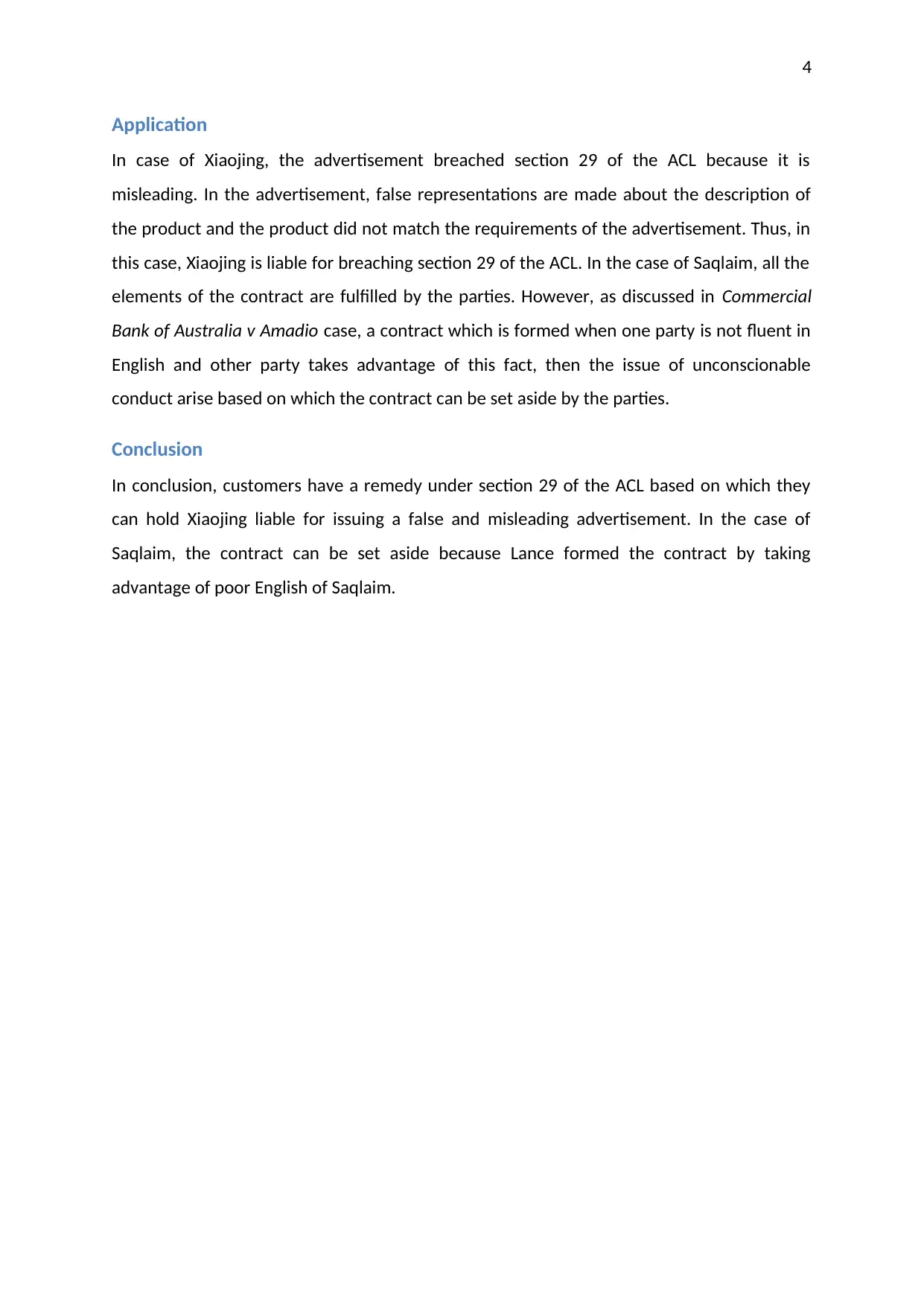
4
Application
In case of Xiaojing, the advertisement breached section 29 of the ACL because it is
misleading. In the advertisement, false representations are made about the description of
the product and the product did not match the requirements of the advertisement. Thus, in
this case, Xiaojing is liable for breaching section 29 of the ACL. In the case of Saqlaim, all the
elements of the contract are fulfilled by the parties. However, as discussed in Commercial
Bank of Australia v Amadio case, a contract which is formed when one party is not fluent in
English and other party takes advantage of this fact, then the issue of unconscionable
conduct arise based on which the contract can be set aside by the parties.
Conclusion
In conclusion, customers have a remedy under section 29 of the ACL based on which they
can hold Xiaojing liable for issuing a false and misleading advertisement. In the case of
Saqlaim, the contract can be set aside because Lance formed the contract by taking
advantage of poor English of Saqlaim.
Application
In case of Xiaojing, the advertisement breached section 29 of the ACL because it is
misleading. In the advertisement, false representations are made about the description of
the product and the product did not match the requirements of the advertisement. Thus, in
this case, Xiaojing is liable for breaching section 29 of the ACL. In the case of Saqlaim, all the
elements of the contract are fulfilled by the parties. However, as discussed in Commercial
Bank of Australia v Amadio case, a contract which is formed when one party is not fluent in
English and other party takes advantage of this fact, then the issue of unconscionable
conduct arise based on which the contract can be set aside by the parties.
Conclusion
In conclusion, customers have a remedy under section 29 of the ACL based on which they
can hold Xiaojing liable for issuing a false and misleading advertisement. In the case of
Saqlaim, the contract can be set aside because Lance formed the contract by taking
advantage of poor English of Saqlaim.
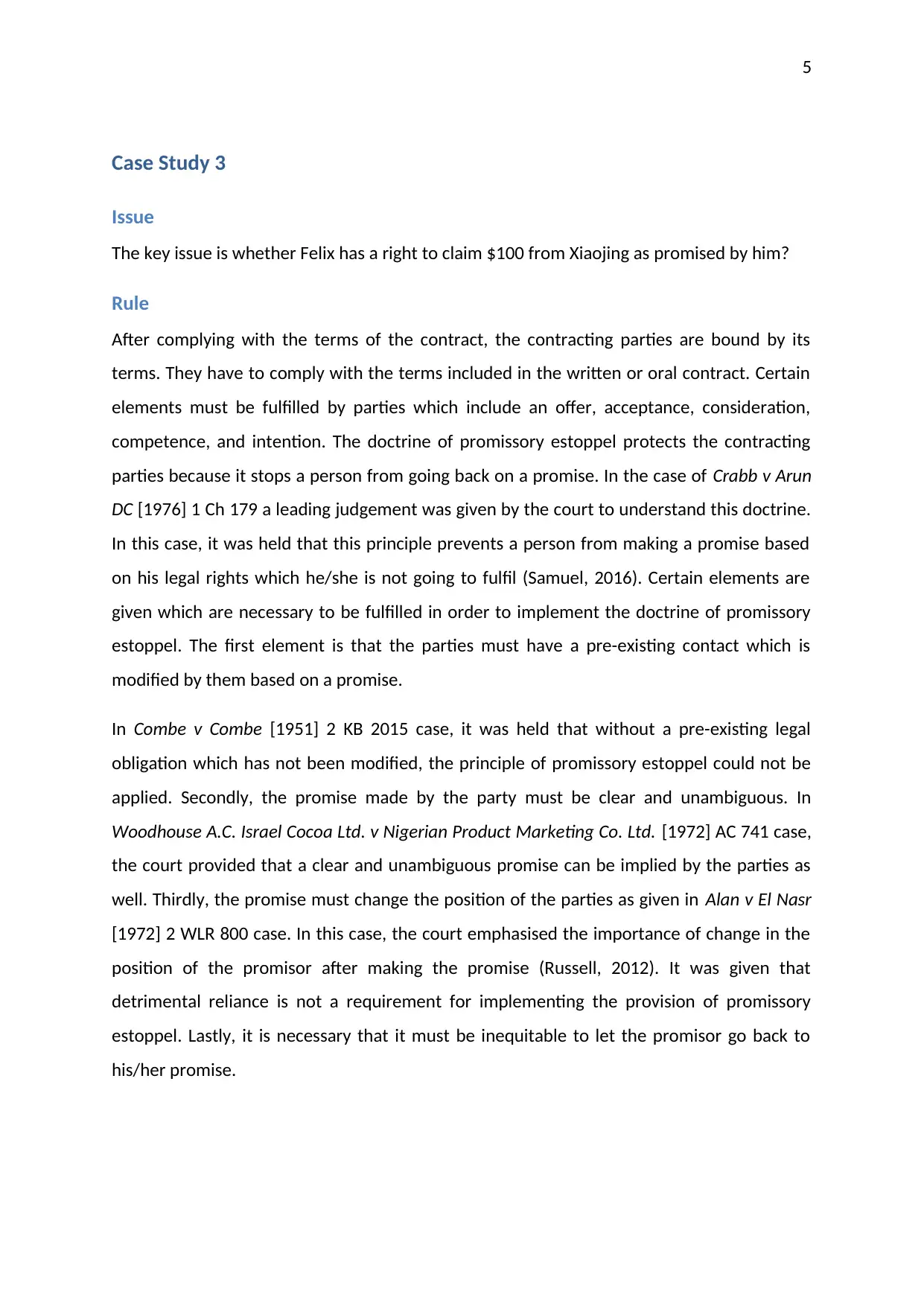
5
Case Study 3
Issue
The key issue is whether Felix has a right to claim $100 from Xiaojing as promised by him?
Rule
After complying with the terms of the contract, the contracting parties are bound by its
terms. They have to comply with the terms included in the written or oral contract. Certain
elements must be fulfilled by parties which include an offer, acceptance, consideration,
competence, and intention. The doctrine of promissory estoppel protects the contracting
parties because it stops a person from going back on a promise. In the case of Crabb v Arun
DC [1976] 1 Ch 179 a leading judgement was given by the court to understand this doctrine.
In this case, it was held that this principle prevents a person from making a promise based
on his legal rights which he/she is not going to fulfil (Samuel, 2016). Certain elements are
given which are necessary to be fulfilled in order to implement the doctrine of promissory
estoppel. The first element is that the parties must have a pre-existing contact which is
modified by them based on a promise.
In Combe v Combe [1951] 2 KB 2015 case, it was held that without a pre-existing legal
obligation which has not been modified, the principle of promissory estoppel could not be
applied. Secondly, the promise made by the party must be clear and unambiguous. In
Woodhouse A.C. Israel Cocoa Ltd. v Nigerian Product Marketing Co. Ltd. [1972] AC 741 case,
the court provided that a clear and unambiguous promise can be implied by the parties as
well. Thirdly, the promise must change the position of the parties as given in Alan v El Nasr
[1972] 2 WLR 800 case. In this case, the court emphasised the importance of change in the
position of the promisor after making the promise (Russell, 2012). It was given that
detrimental reliance is not a requirement for implementing the provision of promissory
estoppel. Lastly, it is necessary that it must be inequitable to let the promisor go back to
his/her promise.
Case Study 3
Issue
The key issue is whether Felix has a right to claim $100 from Xiaojing as promised by him?
Rule
After complying with the terms of the contract, the contracting parties are bound by its
terms. They have to comply with the terms included in the written or oral contract. Certain
elements must be fulfilled by parties which include an offer, acceptance, consideration,
competence, and intention. The doctrine of promissory estoppel protects the contracting
parties because it stops a person from going back on a promise. In the case of Crabb v Arun
DC [1976] 1 Ch 179 a leading judgement was given by the court to understand this doctrine.
In this case, it was held that this principle prevents a person from making a promise based
on his legal rights which he/she is not going to fulfil (Samuel, 2016). Certain elements are
given which are necessary to be fulfilled in order to implement the doctrine of promissory
estoppel. The first element is that the parties must have a pre-existing contact which is
modified by them based on a promise.
In Combe v Combe [1951] 2 KB 2015 case, it was held that without a pre-existing legal
obligation which has not been modified, the principle of promissory estoppel could not be
applied. Secondly, the promise made by the party must be clear and unambiguous. In
Woodhouse A.C. Israel Cocoa Ltd. v Nigerian Product Marketing Co. Ltd. [1972] AC 741 case,
the court provided that a clear and unambiguous promise can be implied by the parties as
well. Thirdly, the promise must change the position of the parties as given in Alan v El Nasr
[1972] 2 WLR 800 case. In this case, the court emphasised the importance of change in the
position of the promisor after making the promise (Russell, 2012). It was given that
detrimental reliance is not a requirement for implementing the provision of promissory
estoppel. Lastly, it is necessary that it must be inequitable to let the promisor go back to
his/her promise.
⊘ This is a preview!⊘
Do you want full access?
Subscribe today to unlock all pages.

Trusted by 1+ million students worldwide
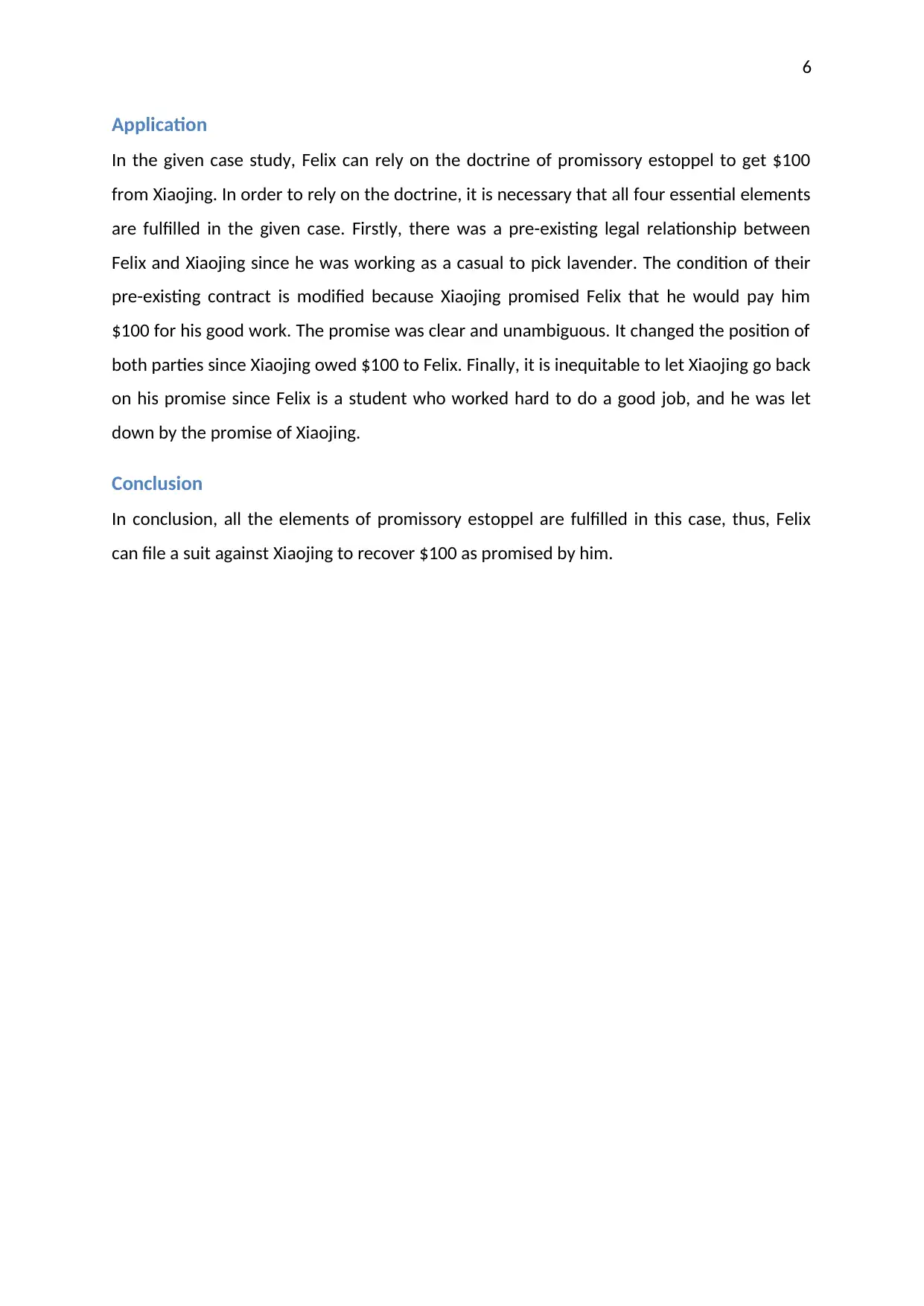
6
Application
In the given case study, Felix can rely on the doctrine of promissory estoppel to get $100
from Xiaojing. In order to rely on the doctrine, it is necessary that all four essential elements
are fulfilled in the given case. Firstly, there was a pre-existing legal relationship between
Felix and Xiaojing since he was working as a casual to pick lavender. The condition of their
pre-existing contract is modified because Xiaojing promised Felix that he would pay him
$100 for his good work. The promise was clear and unambiguous. It changed the position of
both parties since Xiaojing owed $100 to Felix. Finally, it is inequitable to let Xiaojing go back
on his promise since Felix is a student who worked hard to do a good job, and he was let
down by the promise of Xiaojing.
Conclusion
In conclusion, all the elements of promissory estoppel are fulfilled in this case, thus, Felix
can file a suit against Xiaojing to recover $100 as promised by him.
Application
In the given case study, Felix can rely on the doctrine of promissory estoppel to get $100
from Xiaojing. In order to rely on the doctrine, it is necessary that all four essential elements
are fulfilled in the given case. Firstly, there was a pre-existing legal relationship between
Felix and Xiaojing since he was working as a casual to pick lavender. The condition of their
pre-existing contract is modified because Xiaojing promised Felix that he would pay him
$100 for his good work. The promise was clear and unambiguous. It changed the position of
both parties since Xiaojing owed $100 to Felix. Finally, it is inequitable to let Xiaojing go back
on his promise since Felix is a student who worked hard to do a good job, and he was let
down by the promise of Xiaojing.
Conclusion
In conclusion, all the elements of promissory estoppel are fulfilled in this case, thus, Felix
can file a suit against Xiaojing to recover $100 as promised by him.
Paraphrase This Document
Need a fresh take? Get an instant paraphrase of this document with our AI Paraphraser
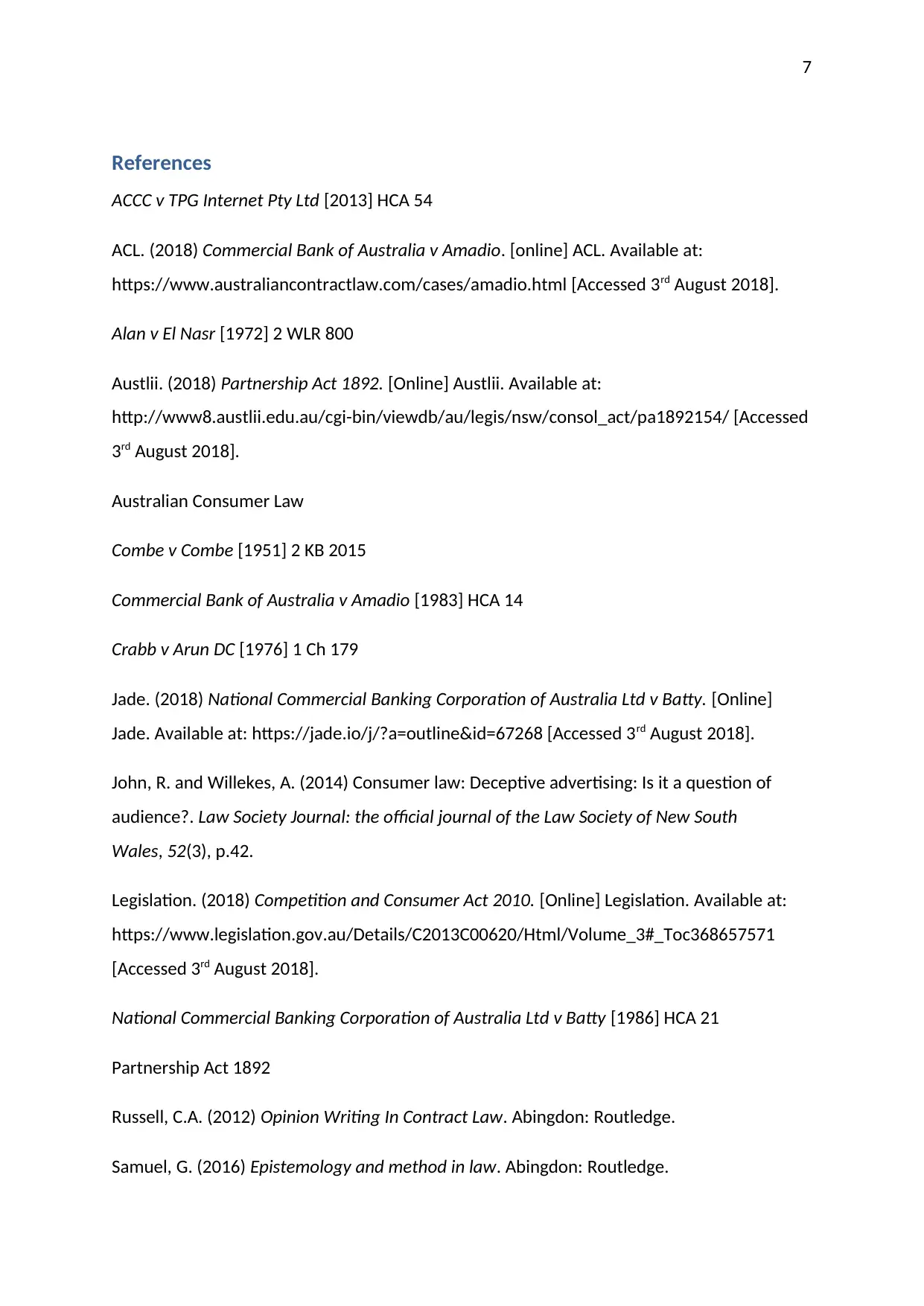
7
References
ACCC v TPG Internet Pty Ltd [2013] HCA 54
ACL. (2018) Commercial Bank of Australia v Amadio. [online] ACL. Available at:
https://www.australiancontractlaw.com/cases/amadio.html [Accessed 3rd August 2018].
Alan v El Nasr [1972] 2 WLR 800
Austlii. (2018) Partnership Act 1892. [Online] Austlii. Available at:
http://www8.austlii.edu.au/cgi-bin/viewdb/au/legis/nsw/consol_act/pa1892154/ [Accessed
3rd August 2018].
Australian Consumer Law
Combe v Combe [1951] 2 KB 2015
Commercial Bank of Australia v Amadio [1983] HCA 14
Crabb v Arun DC [1976] 1 Ch 179
Jade. (2018) National Commercial Banking Corporation of Australia Ltd v Batty. [Online]
Jade. Available at: https://jade.io/j/?a=outline&id=67268 [Accessed 3rd August 2018].
John, R. and Willekes, A. (2014) Consumer law: Deceptive advertising: Is it a question of
audience?. Law Society Journal: the official journal of the Law Society of New South
Wales, 52(3), p.42.
Legislation. (2018) Competition and Consumer Act 2010. [Online] Legislation. Available at:
https://www.legislation.gov.au/Details/C2013C00620/Html/Volume_3#_Toc368657571
[Accessed 3rd August 2018].
National Commercial Banking Corporation of Australia Ltd v Batty [1986] HCA 21
Partnership Act 1892
Russell, C.A. (2012) Opinion Writing In Contract Law. Abingdon: Routledge.
Samuel, G. (2016) Epistemology and method in law. Abingdon: Routledge.
References
ACCC v TPG Internet Pty Ltd [2013] HCA 54
ACL. (2018) Commercial Bank of Australia v Amadio. [online] ACL. Available at:
https://www.australiancontractlaw.com/cases/amadio.html [Accessed 3rd August 2018].
Alan v El Nasr [1972] 2 WLR 800
Austlii. (2018) Partnership Act 1892. [Online] Austlii. Available at:
http://www8.austlii.edu.au/cgi-bin/viewdb/au/legis/nsw/consol_act/pa1892154/ [Accessed
3rd August 2018].
Australian Consumer Law
Combe v Combe [1951] 2 KB 2015
Commercial Bank of Australia v Amadio [1983] HCA 14
Crabb v Arun DC [1976] 1 Ch 179
Jade. (2018) National Commercial Banking Corporation of Australia Ltd v Batty. [Online]
Jade. Available at: https://jade.io/j/?a=outline&id=67268 [Accessed 3rd August 2018].
John, R. and Willekes, A. (2014) Consumer law: Deceptive advertising: Is it a question of
audience?. Law Society Journal: the official journal of the Law Society of New South
Wales, 52(3), p.42.
Legislation. (2018) Competition and Consumer Act 2010. [Online] Legislation. Available at:
https://www.legislation.gov.au/Details/C2013C00620/Html/Volume_3#_Toc368657571
[Accessed 3rd August 2018].
National Commercial Banking Corporation of Australia Ltd v Batty [1986] HCA 21
Partnership Act 1892
Russell, C.A. (2012) Opinion Writing In Contract Law. Abingdon: Routledge.
Samuel, G. (2016) Epistemology and method in law. Abingdon: Routledge.

8
Woodhouse A.C. Israel Cocoa Ltd. v Nigerian Product Marketing Co. Ltd. [1972] AC 741
Woodhouse A.C. Israel Cocoa Ltd. v Nigerian Product Marketing Co. Ltd. [1972] AC 741
⊘ This is a preview!⊘
Do you want full access?
Subscribe today to unlock all pages.

Trusted by 1+ million students worldwide
1 out of 9
Related Documents
Your All-in-One AI-Powered Toolkit for Academic Success.
+13062052269
info@desklib.com
Available 24*7 on WhatsApp / Email
![[object Object]](/_next/static/media/star-bottom.7253800d.svg)
Unlock your academic potential
Copyright © 2020–2025 A2Z Services. All Rights Reserved. Developed and managed by ZUCOL.



